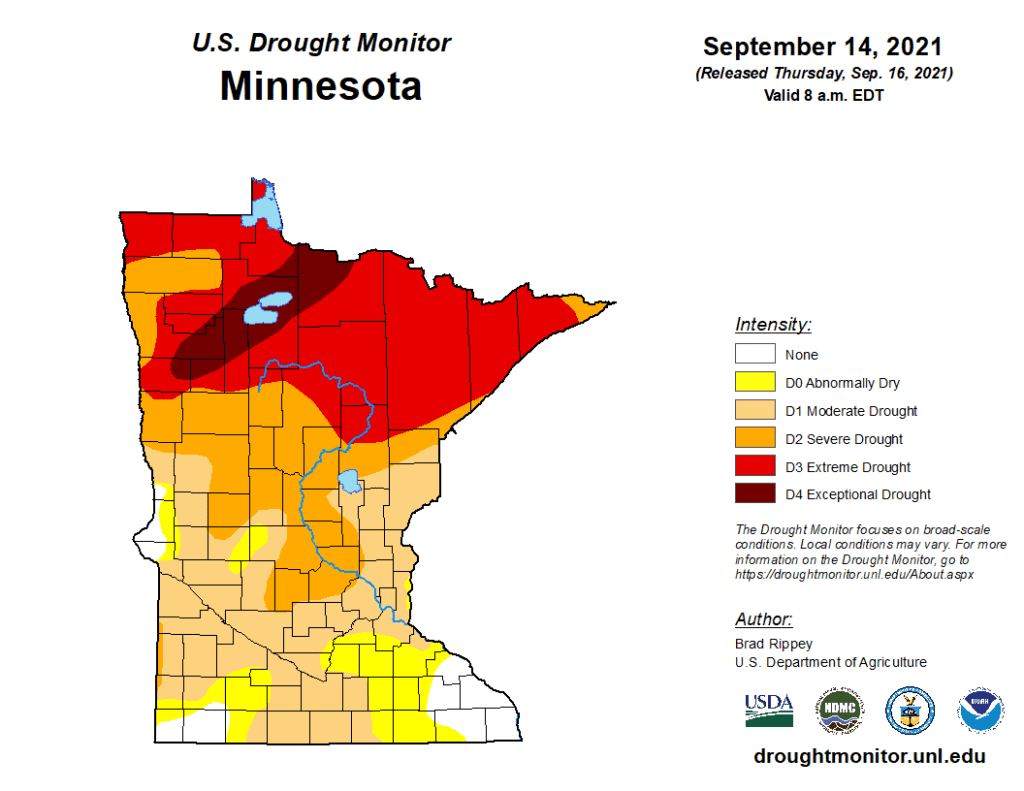Exceptional drought conditions now reported in parts of Minnesota, expand in Wisconsin
As the fall season approaches, parts of the Midwest are continuing to see dry conditions worsen.
In last week’s report, the U.S. Drought Monitor said no parts of Minnesota were in exceptional drought, and just over 10% was in an extreme drought. The percentage of land in an extreme drought is at 16.1%, while 1.4% of the state is now experiencing an exceptional drought.
Counties listed as having at least part of the land having exceptional drought conditions include Aitkin, Carlton, Freeborn, Mower and Pine.
Essentially, all of Minnesota is experiencing some kind of drought, with 0.08% of the state having no abnormally dry conditions, according to the national drought monitor.
At this time last year, there were no parts of Minnesota in exceptional or extreme drought, and less than 1% of the state was in a severe drought. In addition, just over 74% of the state at that time had no kind of dry conditions.
The U.S. Drought Monitor shows the last time Minnesota had exceptional drought conditions was almost exactly two years ago on Sept. 14, 2021. Records show that at that time, a swath of land stretching from the Canadian border southwest into Norman County was experiencing that level of drought.

Exceptional drought conditions are also increasing in Wisconsin, with 2.44% of the state in that condition, and covers parts of Bayfield, Crawford, Douglas, Juneau, Monroe, Richland, Sauk and Vernon Counties. Last week, that percentage was at 0.66%. At this time last year, there were no parts of the state in exceptional, extreme, or severe drought.
Non-drought conditions continue in most of St. Croix County, as well as parts of Dunn and Pierce Counties in western Wisconsin. On the eastern side of the state, there are no drought conditions in parts of Brown, Shawano, Oconto, Marinette and Menominee Counties. Abnormally dry or worse conditions cover more than 96.6% of the state.
The current seven-day forecast from Minnesota’s Weather Authority shows a couple chances of rain, primarily this weekend – showers are possible Saturday night, as well as during the day on Sunday. There is also a much smaller chance of rain on Monday. Cool temperatures are also expected, with the warmest temperatures expected on Saturday.
“We’re really in the fourth-straight year of very dry conditions during the growing season and the third-straight year where those dry growing conditions have actually led to significant drought categories,” said Kenny Blumenfeld, a senior climatologist with the Minnesota Department of Natural Resources.
DNR officials told 5 EYEWITNESS NEWS drought conditions can affect the brilliance of fall colors.
“The good news, I guess, is we haven’t seen any obvious effect on fall colors in recent years,” said Brian Schwingle, a forest health specialist with the DNR.
Most of the Twin Cities metro area is in a severe drought. There are signs of dry conditions in the capital city, where St. Paul Regional Water Services is now encouraging customers to limit outdoor watering to every other day. Customers with odd-numbered addresses are asked to water only on odd-numbered days, while customers with even-numbered addresses are asked to water on even-numbered days.
“I try to water every two to three days,” said Trish Pool, who was gardening at her St. Paul home on Thursday afternoon. “Even with extra watering, [the plants are] still dry.”
Despite her higher water bill, Pool has watched leaves turn brown.
“I looked at some of the annuals a day ago and they’re done for the year, which they normally wouldn’t be,” she said.
Pool trimmed back leaves on some of the plants to try to preserve them amid the dry conditions.
“It’s fun to think about the idea that we can put our energy into the plants but in the end they still need water,” she said.
SPRWS is asking customers to conserve water through the end of the year, with the possibility of enforceable water restrictions in the coming weeks if drought conditions get worse or the goals for reducing use aren’t met.
“Definitely my lawn is suffering, and our trees are suffering,” said Ryan Pfeiffer, who also has straw bale gardens in the backyard of his St. Paul home.
He uses the straw bales to grow his tomatoes.
“I would have to water them every day, whether or not there’s a drought,” he said. “They’re fairly water intensive because a lot evaporates from them.”
The new requested restrictions will force him to cut back watering.
“At this point with the temperatures dropping it shouldn’t matter a whole lot but if the temperatures were to spike I would have trouble with my straw bales,” said Pfeiffer.
CLICK HERE for the latest forecast, and HERE for an interactive radar.